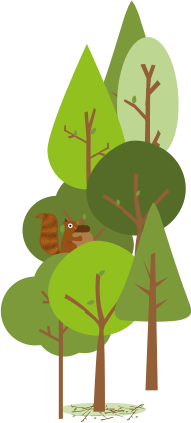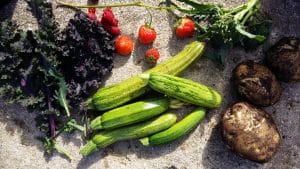

Blog
Adventures in Nature


There was no lie in on Sunday morning – I had to get up to light a fire and rouse the kids to help gather our food. Blackberries are plentiful and elderberries coming in too, so we could make a decent drink. The veg garden provided potatoes, onions, kale and courgettes by the bucket load. 

Lunch almost looked like a proper meal; veg omelettes with potatoes and kale. 

What did we learn from this experiment?
- That modern habits are so ingrained that, even when we knew we weren’t allowed, we automatically reached for the lights or opened the fridge. I had to put notices on each switch and spend most of the day outside, away from temptation and where we could see properly.
- That this method of living takes up most of the day. There was very little time that wasn’t looking for food, cooking food, clearing up or tending the fire. I sympathised with the generations of women before modern cookers, boilers and washing machines. They must have been exhausted.
- That we are addicted to sugar. Even though we had probably allowed ourselves far more sugar than a wartime family were rationed in a week, by lunchtime we were craving chocolate biscuits.
- We became a lot less wasteful. We cleaned our plates and had seconds. We used all the ingredients we had and there was virtually nothing to throw away apart from some peelings for the compost heap.

I enjoyed the whole thing but if I had been told I had to do it all the next day my heart would have sunk. We are so used to food and light being there whenever we want it. Obviously this was just a day and we cheated a lot, but for millions around the world doing without electricity and enough food is a daily existence. Its made me feel very grateful for the luxury of enough light, power and food. And to give up any idea of running away to live simply in the woods. I wouldn’t last a day.
 It was a spur of the moment decision to set off and I left without a map nor any plan of a route, but with a single destination in mind; to get as far away as possible in a short space of time.
It was a spur of the moment decision to set off and I left without a map nor any plan of a route, but with a single destination in mind; to get as far away as possible in a short space of time.
The day had not started out this way. It was the middle of the summer holidays and I had been busy running forest school sessions every day, meanwhile the demanding business of work and homelife was piling up, leaving me feeling overwhelmed. I had a rare day indoors and, with husband off work to look after the kids, I was looking forward to getting on top of the mountain of emails and reclaiming a sense of calm. However, after some initial in-roads and false starts, the broadband went off leaving me shouting at the computer and frustratingly unable to deal with any of the priority tasks on my worryingly long list.
With stress levels rising I decided the only course of action to walk away from it all, turn my back on it and find some peace elsewhere. I decided to set off for the horizon, the heather-clad moors to the west and go as far as I could before I was walking down the other side. The destination was clear, but I decided in the spirit of a spontaneous microadventure I would find my way there without a map and, where there was a choice of route, to always take the road less traveled.
Of course it was easy at first, following the well known paths from my house, with the sight of the moors easily visible a few miles in the distance. 
There was no choice but to retrace my steps back to the beck and this time ignoring the arrow sign, I carried straight on and, to my relief, a walkers’ stile appeared around the next bend. From here the path wandered over pack horse bridges, up ancient paved causeways and past hidden waterfalls I had never seen before, despite being only a few miles from home. At the top of a hill the moorland suddenly appeared, with the purple heather so bright it seemed possible to reach out and touch it. I felt the sun on my face and my spirits lift. Any issues with work felt miles away.
The horizon was in sight but still a climb away. I had to be in Bradford for a meeting that evening so upped my pace, jogging past a reservoir and pushing through bracken and rushes, soaking my feet in the process. Once in the heather the path became more apparent but uneven and dotted with deep boggy holes. 

I have had time since to reflect whether I would have been better off staying at home that day. I may have got some work done and would certainly still have a working phone, but on balance I’m still glad I went. It was a truly beautiful place to be and I have been back since to get some photos. It pricked the all absorbing bubble of work and helped get things in perspective. I have not looked at that horizon in the same way since.

2pm; Everyone has to wash up their own stuff

We consider ourselves lucky to live a beautiful part of the world, a small village just outside Keighley (if you don’t believe me, Google ‘Bronte Country’ and you’ll get the picture). 


In equal measure it is troubling to wake up with the drip of raindrops on your face. I pulled the sleeping bag hood tighter but could hear my eldest stirring. “Mum, how do you stop your face getting wet?” “Errm, do you want to go inside, love?” And the brilliant thing about having holidays at home is that option is always open to you. A conclusion Chris and family had already come to as I heard to field gate creek open and the sound of a car starting up. My youngest meanwhile was still fast asleep so I covered us both up with the now spare sleeping back and went back to sleep. I woke up some time before 6 the next day, having missed the solstice dawn. It was a grey, dull morning but there was still time to get to the lido for the early morning swim if I got a move on, so what did I do? Rolled over and went back to sleep of course – I was on holiday after all!

You can pack a lot into a rucksack and a weekend if you put your mind to it. Our microadventures so far had all come in well under the 24 hour mark and had not left the boundaries of Yorkshire. But with a four day pass from my family duties and an arrangement to meet some old friends for a long weekend in Norfolk it looked like this microadventure could finally tip out of the nano zone.





 e got matches and ovens and houses. But out in the woods those skills became relevant and necessary. With a cracking fire going Adrian set about making a lentil and coconut curry but lamented that that his plastic spork was no good for stirring the dish over the campfire. With a supply of wood on hand and a knife in my rucksack I offered to make a spatula and set to work whittling something quickly before the curry stuck to bottom of the pan. OK, so you might argue that if you can pack a knife, you can pack a wooden spoon, but there was something satisfying about being able to fashion what we needed from the resources at hand.
e got matches and ovens and houses. But out in the woods those skills became relevant and necessary. With a cracking fire going Adrian set about making a lentil and coconut curry but lamented that that his plastic spork was no good for stirring the dish over the campfire. With a supply of wood on hand and a knife in my rucksack I offered to make a spatula and set to work whittling something quickly before the curry stuck to bottom of the pan. OK, so you might argue that if you can pack a knife, you can pack a wooden spoon, but there was something satisfying about being able to fashion what we needed from the resources at hand. 
Packing up to go I realised I had used every item in my rucksack; bivvy bag, spare clothes, lightweight cooking equipment, pocket knife and cash for eating and drinking out all proved useful. But good company, ingenuity and a a sense of humour were the essential resources to pack for a microadventure to remember.
















